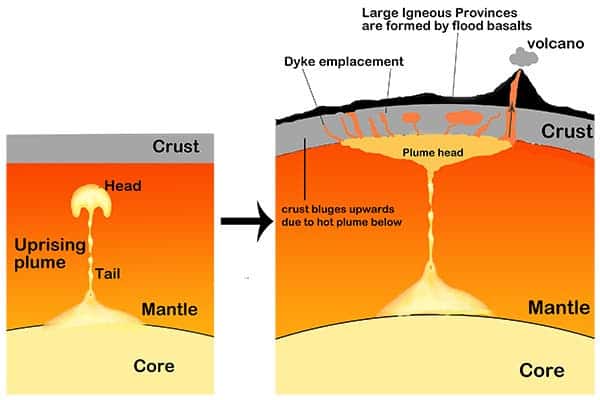Tamu, the largest volcano on Earth, shares characteristics of both a mid-ocean ridge and a shield volcano. Its unique characteristics may force us to rethink a classic volcano formation theory.

When the Tamu Massif was discovered in September 2013, researchers suspected that it might be a single volcano. If this were, in fact, the case, it would make Tamu the single largest shield volcano on the globe. A new study, however, casts doubt on that idea — but shows that Tamu might be even more interesting than we thought.
Tamu is an extinct volcano, dating from the Mesozoic, some 145 million years ago. It is located 1,600 km (990 mi) east of Japan at a spreading ridge triple junction, where three tectonic plates are diverging from each other. However, Tamu was considered to be a shield volcano, comprising almost entirely of fluid lava flows from an emerging mantle plume.
This might not be the case.
Spreading ocean ridges typically form large volcanoes themselves. They also have a very distinct magnetic signature, which researchers can analyze. Essentially, whenever lava comes up the surface it solidifies, and the magnetic minerals inside it tend to align to the Earth’s magnetic poles — like compass needles frozen in time.
The magnetic poles are in constant movement, so when the next generation of lava bubbles up, those minerals will have a slightly different magnetic alignment, and so on. This magnetic analysis can also highlight polarity changes in the magnetic poles, which researchers can then detect.

Linear magnetic anomalies formed by the three ridges had previously been found around Tamu Massif, but it was unclear whether they continued within the volcano itself. Existing information seemed to suggest that this was not the case, hence the argument for Tamu being a shield volcano.
Now, a team of researchers from Texas, China, and Japan analyzed data from 4.6 million magnetic field readings carried over 54 years by ship tracks carrying magnetic measurement equipment. They also had new surveys over the area, finding that linear magnetic anomalies around Tamu Massif blend into linear anomalies over the mountain itself, indicating that the ridge is directly connected to the volcano formation.
“For Tamu Massif, we find dominantly linear magnetic field anomalies caused by crustal blocks of opposite magnetic polarity. This pattern suggests that Tamu Massif is not a shield volcano, but was emplaced by voluminous, focused ridge volcanism,” the study reads.
This is important because it suggests that the Tamu Massif (and potentially other similar areas) were formed through entirely different processes than we thought. A commonly accepted model in volcanology suggests that a hotter (and therefore, lighter) blob of magma, called a mantle plume, slowly rises through the mountain. This plume creates a volcano when it reaches the surface through a vertical succession of lava flows.
But in the case of Tamu, this succession is lateral, not vertical, which the mantle plume theory struggles to incorporate.

William Sager, a geophysicist at the University of Houston and senior author for the paper, was one of the authors of the study which concluded that Tamu is likely a shield volcano, but he says questioning old ideas and putting them to the test is an essential part of science.
“Science is a process and is always changing. There were aspects of that explanation that bugged me, so I proposed a new cruise and went back to collect the new magnetic data set that led to this new result.”
“In science, we always have to question what we think we know and to check and double check our assumptions. In the end, it is about getting as close to the truth as possible—no matter where that leads.”
Also, in light of these findings, Tamu also can’t be considered the world’s largest shield volcano, since it’s not a shield volcano. That honor flows back to Mauna Loa, on the island of Hawaii. As for the largest overall volcanic system in the world, that is dominated by the mid-ocean ridges.
The largest volcano in the world is really the mid-ocean ridge system, which stretches about 65,000 kilometers around the world, like stitches on a baseball,” Sager said. “This is really a large volcanic system, not a single volcano.”
The study ‘Oceanic plateau formation by seafloor spreading implied by Tamu Massif magnetic anomalies’ has been published in Nature Geosciences






